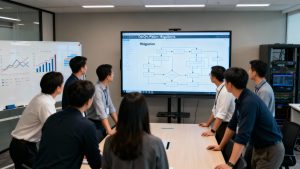The field of software testing has evolved more in the last few years than it had in the previous two decades. This rapid transformation shows no signs of slowing down. By 2030, quality assurance (QA) will move far beyond identifying bugs to focus on automation, intelligence, and continuous quality improvement integrated throughout the software development lifecycle.
AI-Driven Testing
Artificial intelligence is redefining how organizations approach QA. From generating automated test cases to predicting potential defects, AI is enabling smarter, faster, and more efficient testing processes.
Key advancements include:
- Automated generation of test cases based on real user interactions and behavior.
- Predictive analytics that identify high-risk code segments before failures occur.
- Visual AI tools that validate user interface consistency, ensuring pixel-perfect designs.
AI-driven testing allows teams to reduce manual effort, minimize risk, and achieve higher test accuracy—making it a cornerstone of next-generation QA strategies.
Shift-Left QA in DevOps
Shift-left QA has become a fundamental practice within modern Agile and DevOps methodologies. This approach moves testing activities earlier in the development cycle, enabling teams to detect and fix issues during the design or coding phase rather than after deployment.
The benefits are significant:
- Reduced rework and defect resolution time.
- Faster, more predictable release cycles.
- Stronger collaboration between developers, testers, and product owners.
By embedding QA throughout the pipeline, teams can deliver higher quality software with less friction and fewer delays.
Continuous Testing in CI/CD
As organizations embrace continuous integration and delivery (CI/CD), continuous testing is now integral to maintaining quality at speed. Each code commit can trigger automated tests that provide immediate feedback to developers.
This real-time validation process ensures:
- Faster identification of performance issues or regressions.
- Safer deployments, even in frequent release environments.
- Consistent delivery of stable, production-ready software.
Continuous testing helps bridge the gap between speed and reliability, reinforcing confidence across the release process.
Cloud and Virtual Test Environments
The adoption of cloud-based QA environments is accelerating as teams seek flexible, scalable, and cost-effective testing infrastructure. With on-demand access to virtual devices, browsers, and operating systems, cloud testing eliminates the need for costly hardware and setup delays.
Advantages include:
- Greater testing coverage across platforms and geographies.
- Reduced infrastructure costs with pay-as-you-go models.
- Seamless collaboration across distributed teams.
By leveraging virtual environments, QA engineers can execute tests at scale while maintaining accuracy and speed.
QA as a Business Driver
Quality assurance is no longer a back-end process—it’s a key business differentiator. Strong QA practices influence user satisfaction, brand reputation, and market competitiveness. Businesses that treat QA as a strategic function consistently outperform peers by delivering reliable, high-performing software.
Robust QA strategies help:
- Build user trust and brand loyalty.
- Minimize post-launch failures and downtime.
- Gain a competitive advantage through consistency and precision.
As QA becomes more data-driven, its role in decision-making and business value creation will only grow.
Why QA Careers Remain Strong
Despite rapid automation and AI advancements, QA professionals continue to play an essential role in the software ecosystem. The discipline is evolving from manual testing to roles that combine technical expertise, automation strategy, and analytical insight. Those who adapt to tools like AI-driven testing frameworks and DevOps integration will find lasting opportunities ahead.
By 2030, QA careers will remain resilient—valued for their human oversight, strategic thinking, and ability to align technology quality with business objectives.
Final Thoughts
The future of QA is intelligent, integrated, and iterative. Organizations that embrace AI, shift-left testing, continuous validation, and predictive analytics will not only improve product quality but also accelerate delivery and lower costs. In this evolving landscape, quality assurance will stand as both a technical imperative and a strategic advantage.
Read more such articles from our Newsletter here.



